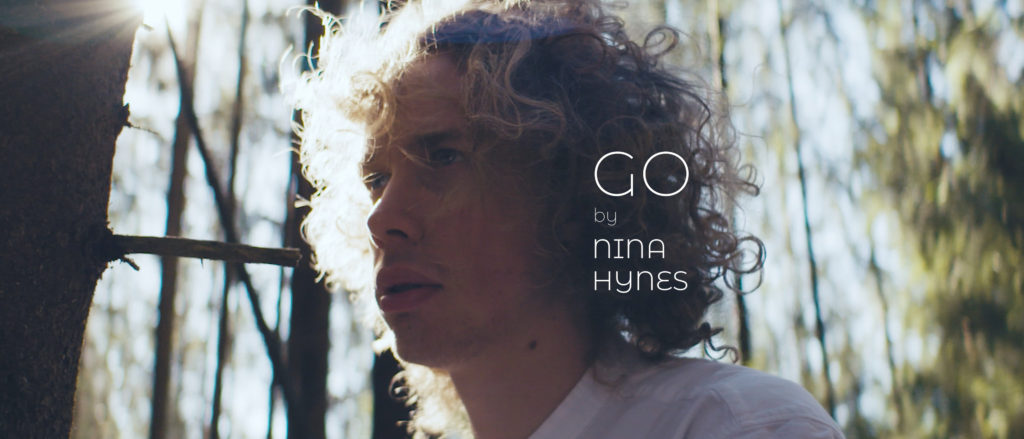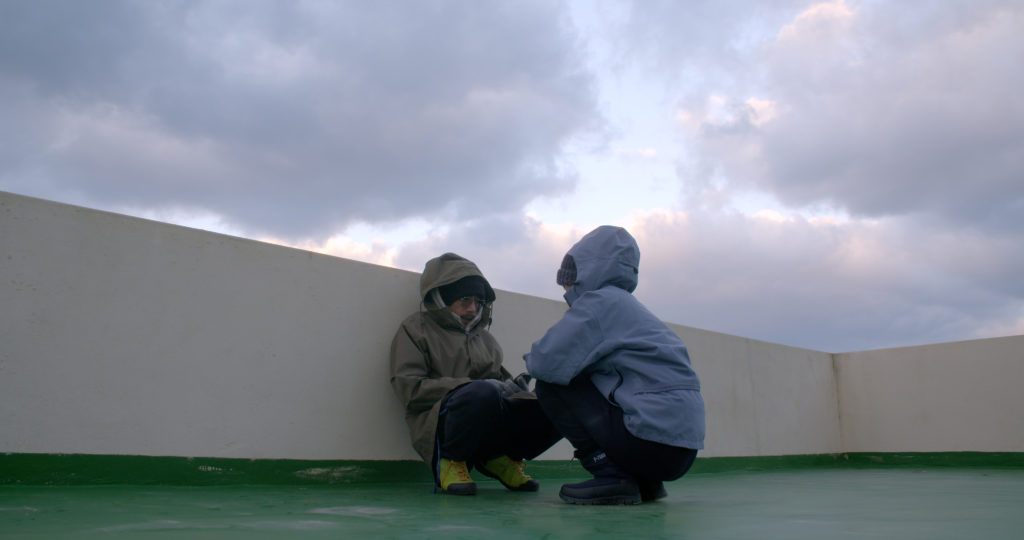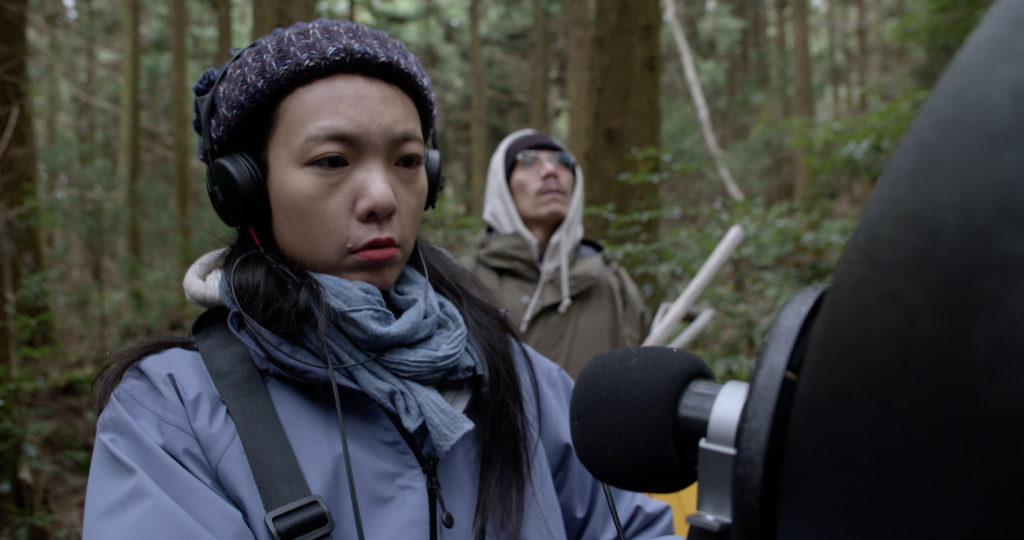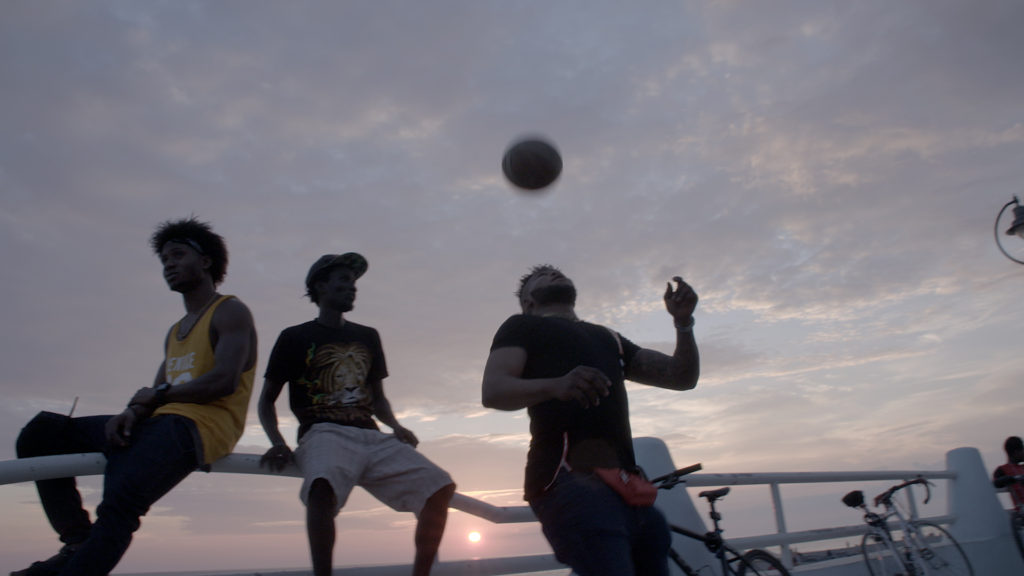N E W S
GO by Nina Hynes. A music video.
A NEW LANDSCAPE
As the walls closed in and the seriousness of the Covid-19 crisis became apparent, as nurses, doctors, hospital porters, cleaners and supermarket checkout workers, became national heroes, I began to ask myself some questions. How can I make a meaningful difference in the current climate as a creative person? What can we as the Contented team do to make some kind of positive contribution in a rapidly changing world. I don’t have the answers but here’s what I have found helpful.
MUSCLE MEMORY
Firstly, pandemic or no pandemic, creativity is like a muscle, it needs to be exercised in order to continue to work effectively. The longer it slacks off the harder it is to get it back up to speed. Secondly, see limitations as assets rather than liabilities. Use what’s available to you. My kids got so bored while being away from their friends that they were happy to join in creative exercises. We shot several scenes from their favourite tv shows with them in the lead roles. You’ll be amazed at how rich the possibilities are.
RECONNECT
Despite my reclusive tendencies and the constant struggle to get away from the screens, I found lockdown to be a great time to be more active online and reach out to friends and acquaintances. Several years ago I used a track by the artist Nina Hynes on a tv commercial, and since that time we have been facebook contacts without really knowing each other. With a new album out and the prospect of a long lockdown looming, Nina put out a facebook call to filmmakers to ask if anyone might have the possibility to create some visuals to accompany the new songs.
ANAMORPHIC
Meanwhile, I had finally received delivery of a new anamorphic lens that I had purchased from Atlas Lens Co. in L.A. and I was very keen to test it out. At first I thought of just going around the city shooting cityscapes, perhaps with a some people shots too, but I quickly realised that this would be a waste and it would take as much effort to do that as to make something simple but specific for someone else to make use of too, whether they had a budget or not. I listened to the album and one song, Go, stood out for me. I particularly liked the line in the chorus ‘Dancing in my head’. In visual terms I felt that it opened a door into an imaginative space and this would enable the character or characters in the video to do things out of the ordinary. The use of the new anamorphic lens, albeit playing down the anamorphic look, would be another tool to pull the story into a slightly surreal territory.
COLLABORATION
Then, I thought about Michael, a professional dancer from Paris now living in Oslo. As well as being the boyfriend of my kids’ French teacher, which is how we met, we had been on the same flight to Oslo from Barcelona in January and had a chance to talk as we headed from the airport back into town. One of the things we discussed was the idea of doing a short dance film. I got in touch after one of the kids’ Skype French classes recently and he agreed that we could do something so long as we maintained social distancing through the shoot. He also said that he could bring two of his dance students on board and contribute as a choreographer. The idea that we wanted to capture was to express, through movement, the feelings of frustration that people have had since the lockdown began. The sense of missing even the small things that we may have always taken for granted. The difficulty of readjusting to the new normal. And, of course, the fact that we have to keep our distance from other people, something that goes against our natural human instincts.
ENGAGE WITH THE MOMENT
So going back to my starting point what can we do to make a positive contribution as creators? Use your skills in service to something bigger – we have also produced a promo film, pro bono, for a national fundraising campaign, and keep creating. Look for ways to make sense of a changing world. Will a music video help the world to heal? Probably not, but possibly just a little. The point is engage creatively with the moment, especially when it’s as monumental and historical as the one we are in right now. It may resonate, it may help someone make sense of something in their life and perhaps even help them get through the day.
Documentary on Telepathic Communication
Moving & Migration
IN FLUX is a short film which was initially made for a group exhibition for “Gyeonggi Museum of Modern Art” in Korea and the “Kaohsiung Museum of Fine Arts” in Taiwan. The exhibition, titled “Moving & Migration”, was held between February and October 2019, and included artists who reside in both countries.
The History of Migration in Modern Korea
Taking a closer look at Korea’s modern history, migration in its current form is a rather recent phenomenon. Korea had remained virtually shut to international migrants until economic development gathered steam in the late 1970s. In the 1990s the Korean government introduced non-skilled labor migration schemes.
Rise in International Marriages
Around the same time a rise in international marriages significantly increased the numbers of migrants. Apparently over 70 percent of all international marriage cases since the early 2000s are between Korean males and foreign females. This is due to the “bachelor surplus” in Korea. Strong values based on Confucianism were the leading factor to pursue tight family planning and selective birth. There was a strong preference for sons up until the 1980s. The result of this is a severe mismatch in the marriage market. There was a lack of native-born brides for a significant amount of Korean males. Especially those who resided in the countryside.
The Phenomenon of Cross-Cultural Marriage
The phenomenon of cross-cultural marriage was the starting point for making IN FLUX. The main characters of the film themselves are a Korean-Chinese intercultural couple. They create an elixir that transcends language barriers to empower, especially, those who came to Korea as marriage immigrants. There was a rigid anti-settlement policies in the past. But now the Korean government finally has installed a legal support system for marriage immigrants. In tandem with the local communities the government still follows a one-sided assimilation of immigrants into Korean society. Immigrants are expected to fill perceived social voids without altering the fabric of society. This kind of static understanding of the migration process leads to a paradoxical situation. While the government provides structural conditions for immigration, it denies the cultural shifts that have to happen to make place for new social realities.
A Different View on Multiculturalism
We made IN FLUX to explore a different view on multiculturalism, also but not only in Korea. Rather than reproducing the narrative of hegemonic concepts of multiculturalism, IN FLUX drifts off to a more poetic idea of multiculturalism. It turns out to be a catalyst for a new reality. It becomes an unpredictable process. Through that it carries the potential for unknown beauty and is not something to be feared and controlled. By doing that, IN FLUX describes multiculturalism as a constant stream of becoming. Instead of locking it down to a fixed, prescribed meaning.
Team Work
After having collaborated on commercial and artistic projects for more than 5 years, we are proud to present IN FLUX now as our first film, which we directed as a team. Thank you very much, Nils & Udo
My Hometown Means the Sea
MY HOMETOWN MEANS THE SEA: A NORTH KOREAN DEFECTOR’S POEM is a short film that has been commissioned by the Washington Post. The film was part of Anna Fifield’s in-depth story on North Korean defectors, who made a living in Seoul.
The film portraits young poet Eun-jeong Oh (26), who left Kyongsong (on the east coast just south of Chongjin in North Korea) in 2009. In an interview with Anna Fifield she describes her life back home and how she ended up writing poetry:
“My dad was a sailor, and he had alcohol problems, but still, I had a happy childhood. I used to swim in the sea every morning and every afternoon after school. My forehead was always white because of the salt from the sea. But then my mom left and my father was killed in a traffic accident, and my sister, who is 11 years younger than me, went to live with our grandma. I was living by myself in our family house. Then in 2009, I escaped, too. In North Korea, I had read only one novel, which I’d borrowed from a neighbor. It was all torn and there were pages missing, but it was all I had. In South Korea, I was always reading. At college, I discovered a wonderful Korean literature professor whose way of teaching was very emotional, and I ended up taking three classes with him. The whole time, I was writing down little notes in my phone. I didn’t even know that the notes I was writing were poetry. I was just scribbling spontaneously.”
“One fall day, I saw a maple tree with red burning foliage on campus. It was so beautiful, but I knew it would all be gone by the following week. Thinking about that made me think of the last time I saw my sister. At the time, I didn’t even know what a metaphor was, I just wrote. The biggest motivation for me behind writing poetry was missing my sister so much. I was so full of hurt, I was overflowing with hurt, and I had to let it out onto the page. It was a whole new world to me. I felt like each cell in my body was coming to life. My first book came out in 2015. It’s called “Calling Home.” I was invited onto a TV channel, and I gave poetry readings. That’s how I was selected as a rising poet, and I was asked to contribute to another collection. A lot of my works are related to North Korea. I have such fond memories of there. Even though there is oppression, there were also moments of happiness, and I don’t have to deny those times. People are hungry and life is hard, but the essence of humanity is the same.”
I would like to thank MIN JOO KIM, JOYCE LEE, JESSE MESNER-HAGE who together produced the film, UDO LEE, who recorded sound and ERIN PARICK O’CONNOR, who edited and color graded the film. The music is by APM MUSIC.
ART ATTACK. A short documentary
SHORT SYNOPSIS
The Demilitarised Zone, in short DMZ, is a buffer zone between North and South Korea where only soldiers patrol. Within spitting distance of this military hotspot each year a range of international artists take part in a residency programme in a small South Korean village called Yangjiri. Each year their artistic practices culminates in an exhibition in and around the village. The outcome of this festival-like event and the relations between the artists and the villagers, range somewhere between documentary and fiction. Not only is communication difficult, but there is also a clash of cultures and values. A small village at the border to North Korea is turned upside down for the sake of what could be understood as pretentious art. What we see is a certain surreality, perhaps even in keeping with the character of the DMZ, which has divided North and South Korea for 65 years.
DIRECTOR’S STATEMENT
ART ATTACK is a short documentary shot in a small Korean village called Yangji-ri located just south of the border with North Korea. Every year the Seoul based gallery Art Sonje hosts a contemporary art festival in this very rural area and the public are carried on buses into and out of Yangji-ri. Since the gallery also runs an artist residency programme in Yangji-ri, the participating artists are invited to stay there for their art practices prior to the festival.
During the production of ART ATTACK I spent a couple of days in Yangji-ri prior to and during the festival. The Goethe Institut Korea, which has been one of the sponsors of the festival kindly invited me to deliver my vision of this unique event. For me the most interesting thing about this event is not so much connected to the work of the artists, it is rather the ‘behind the scenes’ related events, where we really see how two different culture and a very different understanding of what art is. Since the villagers voices are not really heard, the audience is left with a sense of art colonialism. It is my belief that in this sense the culture industry, like any other, is marketing its products, the artist and curators, on the international stage.
I hope that ART ATTACK allows us to reflect on an international art circuit, which often comes across as pretentious. Furthermore the film illustrates how interpersonal relationships are often exploited for one’s personal success. I am well aware that my insight into the relationships between the artists and villagers has been very limited, since I only got to spent 6 days in Yangjiri to shoot the film. But while I was filming the documentary, I did not have a lot of preconception nor a fixed approach or storyline in my head. I tried to immerse myself into the situation without being to judgmental nor taking sides with either the artists or the villagers. The story, as it is, was mainly contextualised in the edit. Here it made sense to juxtapose the artists with the villagers in order to contrast their views and opinions. The resulting film is a critical position on a globalised art world and it’s confrontation with a tiny village in Korea close to the Demilitarised Zone. A small corner of the world where people are probably not too concerned about art.
Despite the sometimes heavy subject matter that touch on the Demilitarised Zone, art colonialism and difficult interpersonal relationships, I understand ART ATTACK merely as a comedic film. I had a lot of fun reviewing the footage during the editing process and some parts made me laugh out loud. To highlight humorous elements in the film, I basically had to divide and then lump together what can be summed up as the art world on the one hand, and the world of the villagers on the other. I hope that based on this editorial generalisation none of the artists or villages in this film feel any of their personal rights are being violated and that they also look at this as a comedic film.
Thank you very much for your interest in this film!
Bikini Words at Arlington Film Festival
Bikini Words at The Arlington International Film Festival
We are incredibly honored to announce that BIKINI WORDS by Nils Clauss will screen in the International Shorts Program of the 8th annual Arlington International Film Festival. The festival takes place from November 1st to November 4th 2018 in Cambridge, Massachusetts.
About BIKINI WORDS
BIKINI WORDS is the first film of a Korea related trilogy, which is followed by LAST LETTERS and PLASTIC GIRLS. What unites the 3 films is a strong focus on issues related to space and architecture, but each film itself stands out with an individual subject matter. BIKNI WORDS talks about new vocabulary that evolved during the rapid industrialisation of South Korea throughout the 1970s and 1980s amongst the factory workers to put names to the radically new aspects of their urbanised lives.
To date BIKINI WORDS has screened at several international film festival and won Best Short Documentary at the Lift-Off Season Awards 2016.
For more information about BIKINI WORDS please read a very thorough interview on film blog DIRECTORS NOTES, which dives into some of the ideas behind and the making of this film.
Screening Time
BIKINI WORDS will screen in the International Shorts Program along with the CLASH OF MORALITY by Vinay Pujara, CUBEMAN by Linda Dombrovsky, LIFE AFTER GUANTANAMO by Esteban Cuevas and DANKE by Antonio Sequeria:
* Fri, Nov 2nd, 9:28 PM at Capital Theatre – 204 Massachusetts Ave, Arlington, MA 02474, USA
For more information about screening times, venues and the festival in general, please visit the ARLINGTON INTERNATIONAL FILM FESTIVAL website.
if … | Opening film World Congress of Architects
Being fathers of young kids ourselves, we get to see the creativity of our children up close every day. There is something precious about it. As Picasso said “Every child is an artist. The problem is how to remain an artist as we grow up.”
We felt that the best way to respond to the call for ideas from the International Union of Architects (UIA), who wanted a film to open the 2017 World Congress of Architects in Seoul, was to take the attendees back to the beginning of their own creative journeys. To take a fun look at nerdy kids, the ones who can sit for hours, even in the age of the iPad, and become engrossed in their drawings and their lego and, ok so we’re back on the screens, their Minecraft worlds. Our aim was to revisit the creative spark in it’s purest form.
We decided we could tell this story best as a kind of inquiry using talking heads interviews to lend some authority to the children’s point of view. We used these interviews along with vignettes where we took some of the kids out into the city and engaged them somehow in an architecturally related task. We were keen to include kids from different parts of the world to reflect the international make-up of the audience. Luckily Seoul has also become so much more international that we were able to find all these kids who are growing up in the city. Many of them have been in Seoul for several years, they speak Korean as well as their mother tongue and go to school with Korean kids.
Seoul as a city is also a fantastic place for architectural diversity, with a great selection of historical, traditional, functional, residential, infrastructural and contemporary constructions to explore. Thank you very much for your interest if…!
Nils Clauss & Neil Dowling from CONTENTED
MINERVA | Global Immersion: Seoul
THE GLOBAL IMMERSION SERIES
Founded in 2014, Minerva Schools is designed around a new vision of higher education that combines a reinvented curriculum, rigorous academic standards, innovative technology, and an immersive global experience. Students study in seven different cities over the course of four years, where they engage with local civic partners to apply classroom knowledge to practical, real-world problems. The above film is part of a series directed by LA based Andrew Hida in collaboration with Minerva’s Creative Director Ayo Seligman. As part of CONTENTED, Nils Clauss and Mini Kim had the pleasure to work with Andrew and Ayo together on the Seoul instalment of this global video series.
“Global Immersion: Seoul” is a short film, which highlights how classroom curriculum extends into the urban fabric and shapes their personal, professional and academic growth. As part of a broader marketing campaign a series of 60-second cuts were also produced for social media engagement.
BRIEF
The target audiences of this series are prospective students and the parents of these students who are seeking to better understand the Minerva global experience. Andrew and Ayo describe how they wanted the viewer to understand the full spectrum of daily life, from the demanding academics, to the immersive social and co-curricular activities. The goal was to make a film which quickly convinces the viewer why they belong at Minerva by telling the story of how the Minerva experience stands apart from that of the traditional university through personal stories of challenge and growth.
CHALLENGES AND RESULT
Over the course of two years, Andrew and Ayo have directed the first four short films in the Global Immersion series. Andrew says that each subsequent episode pushes deeper into stories of personal and professional development as they come into their own. Instead of replicating the same mold for each episode, the storyline instead evolves in parallel to student growth and an evolving world view. This distinct approach enabled Andrew together with Minerva to build on existing story and expand on emotional impact.
In order to achieve the authentic, cinematic documentary style that defines the Minerva brand, Minerva and Andrew say that they assembled a team of cinematographers with a strong background in visual journalism. They further note that weeks of creative design and pre-production proved essential to manage the complex timing and logistics of multiple shooters and photographers, navigating large, foreign cities.
For us at CONTENTED, it was great to take part in this great and meaningful project and we are glad that we were able to offer our services with Nils Clauss as the Director of Photography and Mini Kim as the local producer for the above film. We would like to thank Ayo, Andrew and everyone at Minerva for all their great support.


















